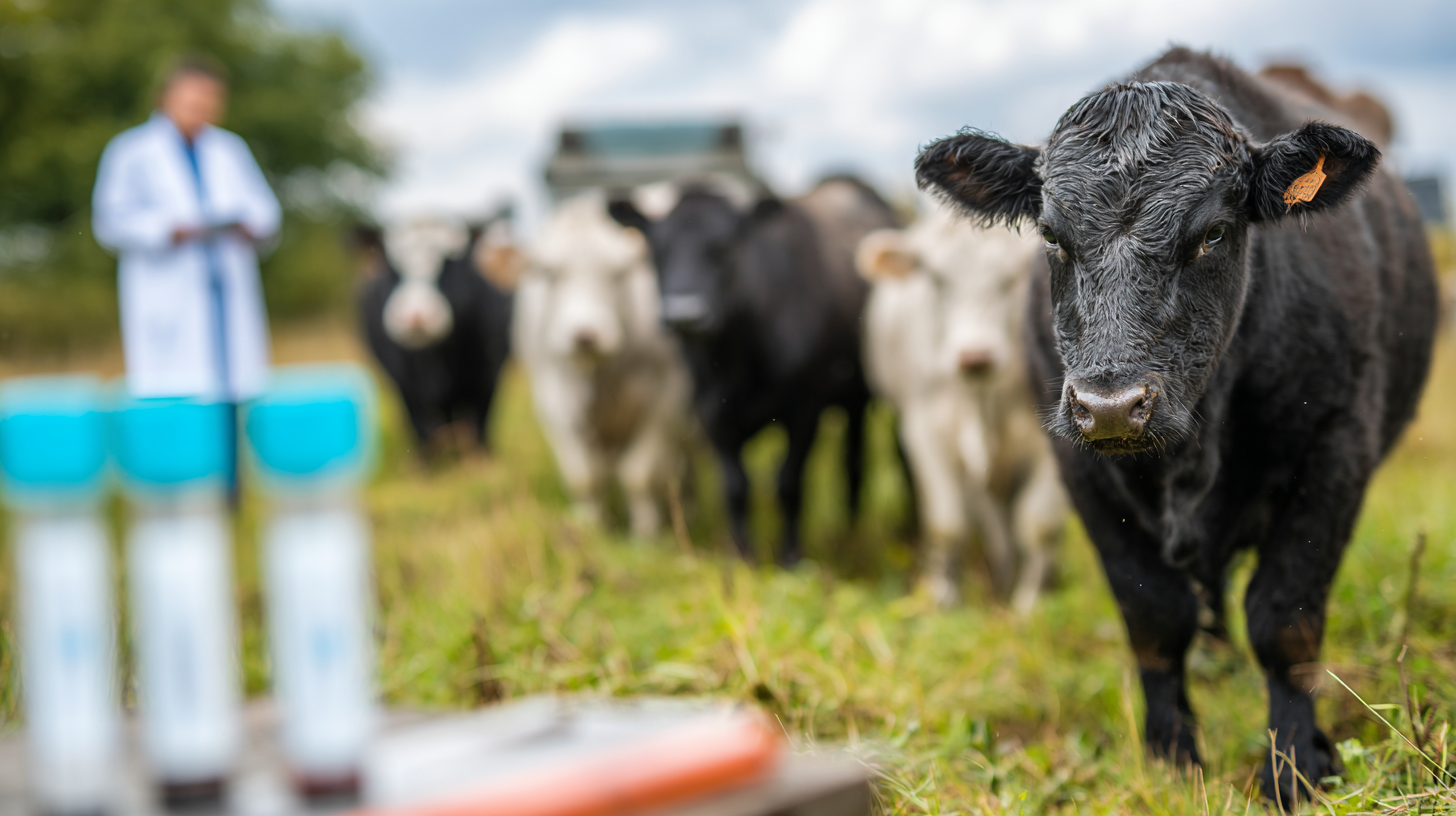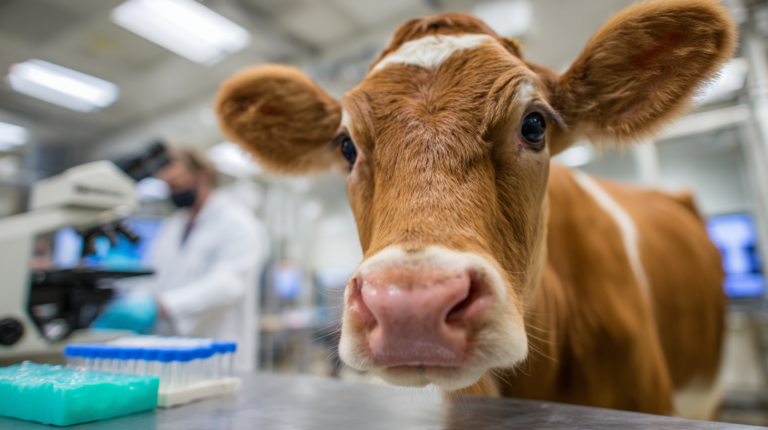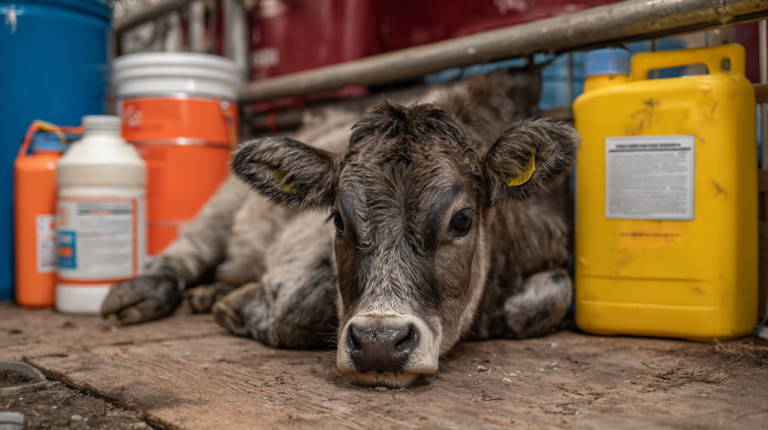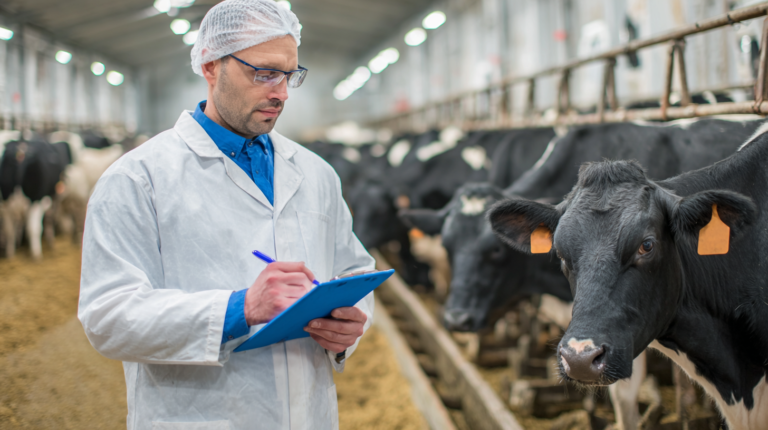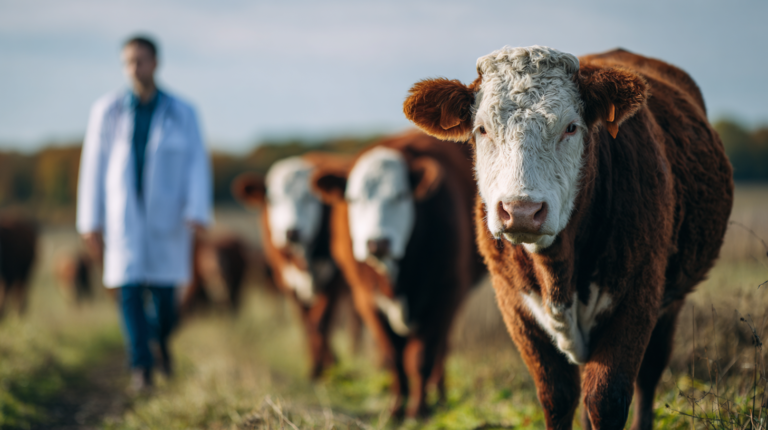Discover effective strategies to combat intestinal parasites in cattle. Learn symptoms, prevention methods, and treatment options from veterinary experts.
Table of Contents
Intestinal parasites in cattle represent one of the most significant threats to livestock health and productivity worldwide. These microscopic invaders silently compromise the digestive system, leading to reduced feed efficiency, poor weight gain, and substantial economic losses for farmers and ranchers. Understanding how to identify, prevent, and treat these parasitic infections is crucial for maintaining healthy herds and ensuring sustainable cattle operations.
The impact of intestinal parasites extends far beyond individual animal health. According to the American Veterinary Medical Association, parasitic infections in cattle cost the U.S. livestock industry approximately $2 billion annually in treatment costs, reduced productivity, and mortality. This staggering figure underscores the importance of implementing comprehensive parasite management strategies that protect both animal welfare and agricultural profitability.
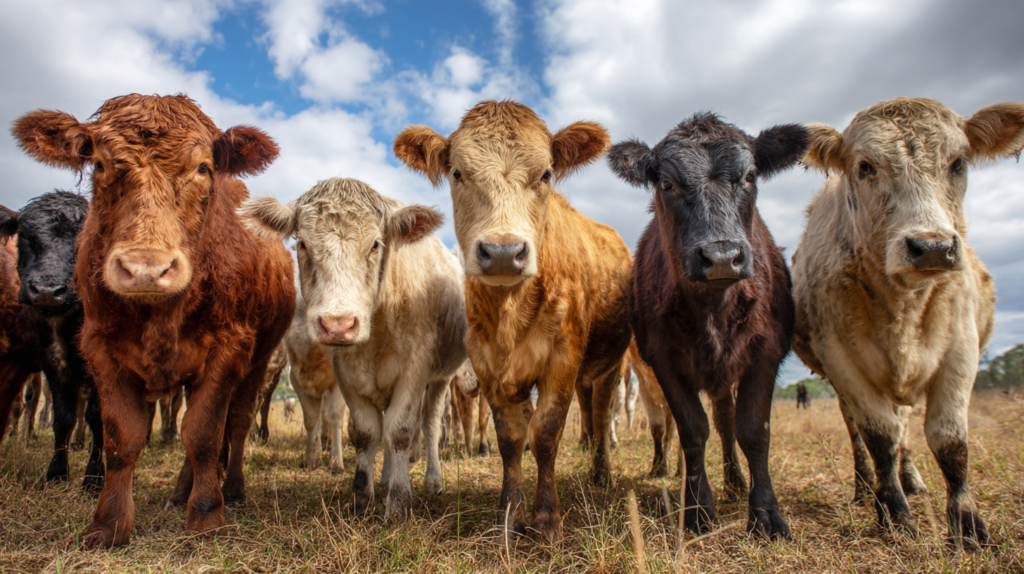
Modern cattle operations face an increasingly complex parasitic landscape, with traditional treatment methods encountering resistance issues and new challenges emerging from climate change and evolving farming practices. The key to successful parasite management lies in adopting an integrated approach that combines prevention, early detection, targeted treatment, and ongoing monitoring. This comprehensive guide will explore six powerful strategies that have proven effective in combating intestinal parasites in cattle, providing practical insights backed by veterinary science and real-world application.
| Parasite Type | Scientific Name | Primary Location | Severity Level | Key Symptoms |
|---|---|---|---|---|
| Roundworms | Ostertagia ostertagi | Abomasum | High | Weight loss, diarrhea, poor coat condition |
| Brown Stomach Worm | Ostertagia circumcincta | Stomach lining | High | Reduced appetite, bottle jaw, anemia |
| Lungworms | Dictyocaulus viviparus | Respiratory tract | Moderate | Coughing, difficulty breathing, reduced performance |
| Liver Flukes | Fasciola hepatica | Liver bile ducts | High | Jaundice, liver damage, weight loss |
| Coccidia | Eimeria species | Intestinal tract | Moderate | Bloody diarrhea, dehydration, poor growth |
| Tapeworms | Moniezia species | Small intestine | Low | Mild digestive upset, segments in feces |
Understanding Intestinal Parasites in Cattle
Intestinal parasites in cattle encompass a diverse group of organisms that inhabit the digestive tract, ranging from microscopic protozoa to large worms visible to the naked eye. These parasites have evolved sophisticated mechanisms to survive and reproduce within their bovine hosts, often causing significant damage in the process. The most common intestinal parasites affecting cattle include roundworms (nematodes), tapeworms (cestodes), flukes (trematodes), and various protozoan species such as coccidia and cryptosporidia.
Roundworms represent the most prevalent category of intestinal parasites in cattle, with species like Ostertagia ostertagi, Haemonchus placei, and Trichostrongylus axei causing substantial economic losses worldwide. These parasites complete their life cycles both within the host and in the external environment, making them particularly challenging to control. The brown stomach worm (Ostertagia ostertagi) alone is responsible for an estimated $1.7 billion in annual losses to the North American cattle industry, according to research published in the Journal of Veterinary Parasitology.
The life cycles of these parasites typically involve several stages, beginning with eggs passed in feces that develop into infective larvae under suitable environmental conditions. Cattle become infected by ingesting these larvae while grazing, leading to adult parasite establishment in the intestinal tract. Understanding these life cycles is fundamental to developing effective control strategies, as different stages may require different intervention approaches.
Climate change has significantly impacted parasite distribution and prevalence patterns. Warmer temperatures and altered precipitation patterns have extended the survival periods of parasite eggs and larvae in the environment, while also expanding the geographic range of certain parasitic species. Dr. Sarah Martinez, a veterinary parasitologist at Colorado State University, notes that “rising temperatures have accelerated parasite development rates, leading to more generations per year and increased infection pressure on cattle herds.”
The economic impact of intestinal parasites manifests through multiple pathways, including reduced feed conversion efficiency, decreased milk production in dairy cattle, poor reproductive performance, and increased veterinary costs. Subclinical infections often go undetected but can reduce daily weight gains by 0.2 to 0.5 pounds per day, representing significant financial losses over time. Additionally, parasitized cattle show increased susceptibility to other diseases due to compromised immune function, further compounding the economic burden.
Recognizing Symptoms and Early Warning Signs
Early detection of intestinal parasites in cattle is crucial for implementing timely intervention strategies and preventing widespread herd infection. However, recognizing parasitic infections can be challenging, as symptoms often develop gradually and may be mistaken for other health issues or management problems. Successful parasite management programs rely on vigilant observation and systematic monitoring protocols that can identify infections before they reach critical levels.
The clinical signs of intestinal parasites in cattle vary depending on the parasite species, infection intensity, and the animal’s age and immune status. Young cattle are generally more susceptible to severe parasitic infections due to their developing immune systems and lack of previous exposure. Common symptoms include diarrhea, poor body condition, rough hair coat, reduced appetite, and decreased activity levels. In severe cases, cattle may exhibit signs of anemia, characterized by pale mucous membranes and weakness.
Diarrhea represents one of the most frequently observed symptoms of intestinal parasites, particularly with coccidial infections and certain roundworm species. The consistency and color of fecal matter can provide valuable diagnostic clues, with watery, bloody, or mucoid diarrhea indicating different parasitic conditions. Chronic diarrhea leads to dehydration and electrolyte imbalances, further compromising the animal’s health and productivity.
Weight loss or poor weight gain despite adequate nutrition often signals parasitic infection, especially in growing cattle. Parasites interfere with nutrient absorption and metabolism, leading to reduced feed efficiency and suboptimal growth rates. A study conducted by the University of Georgia found that cattle with moderate to heavy parasite loads showed 15-25% reductions in average daily gain compared to parasite-free animals.
Changes in hair coat quality and appearance frequently accompany parasitic infections. Infected cattle often develop dull, rough, or brittle hair coats that lack the healthy shine of parasite-free animals. This symptom results from nutritional deficiencies caused by parasitic interference with nutrient absorption and utilization. The hair coat changes typically become more pronounced as infection intensity increases.
Behavioral changes in cattle can provide early warning signs of parasitic infection. Infected animals may show reduced grazing activity, increased lying time, or reluctance to move. These behavioral modifications often precede more obvious clinical symptoms and can be valuable indicators for attentive managers. Additionally, cattle with heavy parasite loads may exhibit signs of abdominal discomfort, such as frequent position changes or unusual posturing.
This illustrated checklist would display common symptoms and diagnostic indicators, helping cattle managers systematically evaluate their herds for parasitic infections. The visual guide would include photographic examples of different diarrhea types, body condition scoring charts, and behavioral observation points.
| Treatment Method | Active Ingredient | Target Parasites | Effectiveness | Withdrawal Period | Application Method |
|---|---|---|---|---|---|
| Ivermectin Pour-On | Ivermectin 0.5% | Roundworms, Lungworms | 95-98% | 35 days | Topical application along backline |
| Albendazole Drench | Albendazole 10% | Liver flukes, Roundworms | 90-95% | 27 days | Oral drench administration |
| Fenbendazole Paste | Fenbendazole 10% | Multiple roundworms, Tapeworms | 85-92% | 8 days | Oral paste gun application |
| Levamisole Injectable | Levamisole 18.15% | Roundworms, Lungworms | 88-94% | 48 hours | Subcutaneous injection |
| Copper Bolus | Copper sulfate | Liver flukes, Some roundworms | 70-85% | 0 days | Oral bolus gun administration |
| Rotational Grazing | Management practice | All intestinal parasites | 60-80% | N/A | Pasture rotation every 3-4 weeks |
1. Strategic Deworming Protocols
Strategic deworming represents the cornerstone of effective parasite management in cattle operations, requiring careful planning and execution to maximize efficacy while minimizing the development of anthelmintic resistance. Unlike blanket treatment approaches, strategic deworming involves targeted administration of anthelmintic medications based on scientific principles of parasite biology, environmental conditions, and herd management factors.
The timing of deworming treatments is critical to their success, with optimal timing varying based on geographic location, climate conditions, and specific parasite species present. In temperate regions, strategic deworming typically occurs in late spring or early summer when environmental conditions favor parasite development and transmission. This timing targets parasites before they reach peak reproductive capacity, reducing overall pasture contamination and subsequent infection pressure.
Modern deworming protocols emphasize the importance of using the correct anthelmintic class for specific parasitic infections. The three major classes of anthelmintics—benzimidazoles, macrocyclic lactones, and imidazothiazoles—each have different mechanisms of action and efficacy spectra. Benzimidazoles, including albendazole and fenbendazole, work by disrupting parasite cellular function and are effective against most roundworms and some tapeworms. Macrocyclic lactones, such as ivermectin and moxidectin, target the nervous system of parasites and provide extended residual activity. Imidazothiazoles, including levamisole, affect neuromuscular function and are particularly effective against certain roundworm species.
Dosage accuracy is fundamental to successful deworming outcomes. Under-dosing can lead to treatment failure and promote resistance development, while over-dosing wastes resources and may cause adverse effects. Weight-based dosing requires accurate estimation of individual animal weights or use of appropriate weighing equipment. Many operations utilize weight tapes or visual estimation techniques, but these methods can be inaccurate and should be validated with actual scale weights when possible.
The concept of targeted selective treatment (TST) has gained prominence in modern parasite management strategies. TST involves treating only animals that require treatment based on individual assessment criteria, rather than treating entire herds. This approach helps preserve anthelmintic susceptibility by maintaining refugia—populations of parasites that remain unexposed to treatment and therefore maintain drug sensitivity. Criteria for TST may include fecal egg counts, body condition scores, or other clinical indicators.
Rotation of anthelmintic classes is essential for preventing resistance development. Systematic rotation involves using different drug classes in sequence, allowing parasite populations to regain sensitivity to previously used medications. The rotation schedule should be based on the pharmacokinetic properties of each drug class and local resistance patterns. Some experts recommend annual rotation, while others advocate for longer intervals based on specific circumstances.
Post-treatment monitoring is crucial for evaluating deworming efficacy and detecting potential resistance issues. Fecal egg count reduction tests (FECRT) performed 14-21 days after treatment can assess the percentage reduction in egg counts, with reductions below 90% indicating possible resistance. Regular monitoring allows for early detection of resistance problems and adjustment of treatment protocols accordingly.
2. Pasture Management and Rotational Grazing
Effective pasture management represents one of the most powerful tools for controlling intestinal parasites in cattle, working by breaking parasite life cycles and reducing environmental contamination. The principle behind strategic pasture management lies in understanding that most cattle parasites require time in the external environment to develop into infective stages, making them vulnerable to environmental manipulation and management practices.
Rotational grazing systems offer significant advantages for parasite control by allowing periodic removal of cattle from contaminated pastures. When cattle are moved to clean pastures, they are separated from the majority of infective larvae that have developed from eggs deposited during previous grazing periods. The length of time cattle remain off a pasture depends on local climate conditions, parasite species present, and environmental factors affecting larval survival.
The concept of “safe pastures” is fundamental to rotational grazing systems designed for parasite control. Safe pastures are those that have been free of cattle for sufficient time to allow natural die-off of infective larvae, or those that have been grazed by other livestock species that do not share the same parasite species. Research conducted by Auburn University demonstrated that pastures rested for 3-4 months during hot, dry conditions showed significant reductions in infective larval populations.
Multi-species grazing represents an innovative approach to pasture-based parasite control, taking advantage of the fact that most intestinal parasites are host-specific. By grazing cattle with sheep, goats, or other livestock species, managers can reduce parasite loads through biological competition and pasture cleaning effects. Dr. James Thompson, a grazing systems specialist at the University of Arkansas, explains that “multi-species grazing creates a natural vacuum cleaner effect, where different species consume infective larvae that are not harmful to them but would infect cattle.”
Pasture renovation and improvement strategies can significantly impact parasite survival and transmission. Proper drainage, fertilization, and weed control create environmental conditions that are less favorable for parasite development. Standing water and overgrazed areas with heavy fecal contamination provide ideal conditions for parasite multiplication, while well-drained, properly managed pastures support lower parasite populations.
The timing of pasture moves is critical to maximizing parasite control benefits. Moving cattle before peak larval emergence periods can dramatically reduce infection pressure. In many regions, this occurs during warm, moist conditions when environmental development is most rapid. Weather monitoring and understanding local parasite development patterns enable managers to optimize move timing for maximum benefit.
Stocking density management plays a crucial role in parasite control through pasture management. Overstocking leads to increased fecal deposition per unit area, higher parasite egg concentrations, and greater infection pressure. Proper stocking rates allow for adequate pasture rest periods and reduce the likelihood of cattle grazing close to fecal deposits where infective larvae concentrate.
Supplemental feeding strategies can complement pasture management for parasite control. Providing feed sources that keep cattle away from ground level can reduce ingestion of infective larvae. Additionally, certain feed additives and supplements may enhance immune function and reduce parasite establishment. Research has shown that cattle with adequate protein and mineral nutrition show improved resistance to parasitic infections.
3. Nutritional Support and Immune System Enhancement
Nutritional support plays a pivotal role in enhancing cattle immunity against intestinal parasites, with well-nourished animals demonstrating significantly greater resistance to parasitic infections and faster recovery from established infections. The relationship between nutrition and parasite resistance is complex and multifaceted, involving protein metabolism, mineral balance, vitamin status, and energy availability. Understanding these interactions enables cattle managers to develop feeding strategies that support natural defense mechanisms while maintaining optimal production performance.
Protein nutrition is particularly crucial for parasite resistance, as adequate protein levels support antibody production, cellular immune responses, and tissue repair processes. Research published in the Journal of Animal Science demonstrated that cattle receiving adequate protein nutrition showed 30-40% lower fecal egg counts compared to protein-deficient animals when exposed to identical parasite challenges. The quality of protein is equally important, with high-quality proteins providing essential amino acids necessary for immune function.
Mineral supplementation represents another critical component of nutritional support for parasite resistance. Copper, zinc, selenium, and cobalt are particularly important for immune function and parasite resistance. Copper deficiency has been linked to increased susceptibility to parasitic infections, while adequate zinc levels support wound healing and immune cell function. Selenium works as an antioxidant, protecting cells from damage caused by parasitic infections and supporting overall immune system function.
Vitamin supplementation can enhance natural parasite resistance, with vitamins A, D, and E playing particularly important roles. Vitamin A supports mucosal immunity in the digestive tract, creating barriers against parasite establishment. Vitamin D modulates immune responses and may enhance resistance to certain parasitic infections. Vitamin E works synergistically with selenium as an antioxidant, protecting cells from oxidative damage associated with parasitic infections.
Energy balance significantly impacts parasite resistance, with energy-deficient cattle showing increased susceptibility to parasitic infections. During periods of negative energy balance, such as late pregnancy or early lactation, cattle may show reduced immune function and increased parasite establishment. Providing adequate energy through high-quality forages or concentrates supports immune function and helps maintain parasite resistance.
Specialized nutritional supplements have shown promise in supporting parasite resistance. Probiotics and prebiotics can enhance gut health and immune function, potentially reducing parasite establishment and improving recovery from infections. Certain plant compounds, such as tannins found in some forages, have demonstrated anti-parasitic properties and may complement traditional control methods.
The timing of nutritional support is crucial for maximizing benefits. Providing enhanced nutrition during periods of increased parasite challenge, such as spring turnout or during stressful management events, can help maintain immune function when animals are most vulnerable. Nutritional support should be viewed as a long-term investment in herd health rather than a short-term intervention.
Feed quality and safety considerations are essential when implementing nutritional support programs. Contaminated feeds can introduce additional pathogens or toxins that compromise immune function and increase parasite susceptibility. Regular feed testing and proper storage practices ensure that nutritional programs support rather than compromise animal health.
4. Environmental Management and Sanitation
Environmental management and sanitation practices form the foundation of comprehensive parasite control programs, targeting the external stages of parasite life cycles that occur outside the host animal. These practices are particularly effective because they address parasite populations before they can infect cattle, breaking the transmission cycle and reducing overall infection pressure. Successful environmental management requires understanding parasite biology, environmental factors affecting survival, and practical implementation strategies.
Water source management represents a critical component of environmental parasite control. Contaminated water sources can harbor various parasitic stages and serve as focal points for transmission. Stagnant water, particularly in areas with heavy fecal contamination, creates ideal conditions for parasite development and concentration. Providing clean, fresh water through automatic waterers or regularly cleaned tanks reduces parasite exposure and improves overall herd health.
Drainage and water management systems should be designed to prevent the accumulation of standing water in areas where cattle congregate. Poor drainage around water sources, feeding areas, and shelters creates environments favorable for parasite development. Installing proper drainage systems, maintaining water flow, and preventing water accumulation in low-lying areas significantly reduce parasite survival and transmission opportunities.
Feed storage and handling practices directly impact parasite transmission risk. Contaminated feed can introduce parasites directly into cattle, while improper storage can attract rodents and other vectors that may carry parasitic stages. Storing feed in clean, dry conditions and using appropriate storage containers prevents contamination and reduces parasite exposure. Additionally, avoiding feeding cattle on the ground, particularly in areas with heavy fecal contamination, reduces ingestion of infective larvae.
Facility design and maintenance play crucial roles in parasite control. Properly designed facilities facilitate cleaning and disinfection while preventing the accumulation of organic matter that supports parasite development. Concrete surfaces are easier to clean and disinfect than dirt floors, while adequate ventilation prevents the humid conditions that favor parasite survival. Regular cleaning and removal of organic debris reduce parasite populations and transmission opportunities.
Manure management represents one of the most important aspects of environmental parasite control. Fresh manure contains millions of parasite eggs that can develop into infective stages under suitable conditions. Proper manure management involves regular removal, appropriate composting or treatment, and strategic application to fields. Composting manure at temperatures above 140°F (60°C) for extended periods kills most parasitic stages, while proper aging allows natural die-off of infective larvae.
Rodent and pest control programs complement environmental management by reducing alternative hosts and vectors for certain parasites. Rodents can carry parasitic stages and contaminate feed and water sources. Implementing comprehensive pest control programs, including exclusion methods and population control, reduces parasite transmission opportunities and improves overall sanitation.
Vector control strategies target insects and other arthropods that may serve as intermediate hosts or mechanical vectors for certain parasites. Fly control is particularly important, as flies can mechanically transmit parasitic stages and create stress that compromises immune function. Integrated pest management approaches, including biological control, habitat modification, and targeted treatments, provide effective vector control while minimizing environmental impact.
5. Monitoring and Diagnostic Testing
Systematic monitoring and diagnostic testing form the backbone of effective parasite management programs, providing the data necessary to make informed decisions about treatment timing, efficacy evaluation, and resistance monitoring. Modern diagnostic approaches combine traditional techniques with advanced technologies to provide comprehensive assessment of parasite populations and their impact on cattle health and performance.
Fecal egg counting (FEC) remains the gold standard for monitoring intestinal parasite infections in cattle. This technique involves collecting fresh fecal samples and using specialized laboratory procedures to count and identify parasite eggs. The McMaster technique, widely used in veterinary diagnostics, provides quantitative results expressed as eggs per gram of feces. Regular FEC monitoring allows managers to track infection levels, evaluate treatment efficacy, and identify animals requiring intervention.
The interpretation of fecal egg counts requires understanding that egg counts don’t always correlate directly with parasite burden or clinical impact. Factors such as immune status, parasite species, and individual animal variation can affect egg production and detection. Generally, counts above 200-500 eggs per gram indicate significant infections requiring intervention, while lower counts may not necessitate immediate treatment. However, these thresholds vary depending on the specific parasite species and local conditions.
Sampling strategies for fecal egg counting must balance accuracy with practicality. Collecting samples from 10-15 animals per group provides statistically valid estimates of group infection levels while remaining logistically feasible. Sampling should target animals representative of the group, avoiding selection bias that might skew results. Fresh samples are preferred, but samples can be refrigerated for up to 48 hours if immediate processing is not possible.
Advanced diagnostic techniques are increasingly available for parasite identification and quantification. Molecular diagnostics, including PCR-based methods, can identify specific parasite species and detect infections that might be missed by traditional methods. These techniques are particularly valuable for identifying drug-resistant parasite strains and monitoring treatment efficacy. However, molecular diagnostics typically require specialized laboratory facilities and may not be practical for routine monitoring.
Coproculture techniques involve incubating fecal samples under controlled conditions to allow parasite eggs to develop into identifiable larval stages. This technique enables species-specific identification of parasites, which is crucial for selecting appropriate treatments and understanding resistance patterns. Coproculture results take longer to obtain than simple egg counts but provide more detailed information about parasite populations.
Body condition scoring and performance monitoring complement laboratory diagnostics by providing practical indicators of parasite impact. Regular assessment of body condition, growth rates, and reproductive performance can identify parasitic impacts before they become severe. Digital photography and measurement techniques enable objective monitoring of animal condition over time, providing valuable data for management decisions.
Integrated monitoring systems combine multiple diagnostic approaches to provide comprehensive assessment of parasite status. These systems typically include regular fecal egg counting, periodic coproculture for species identification, performance monitoring, and clinical observation. Data management systems help organize and interpret monitoring results, identifying trends and triggering management interventions when necessary.
The frequency of monitoring depends on various factors, including parasite pressure, management system, and risk factors. High-risk operations may require monthly monitoring during peak transmission seasons, while lower-risk operations might monitor quarterly or seasonally. The key is establishing a routine that provides adequate information for decision-making while remaining economically feasible.
6. Integrated Biological Control Methods
Integrated biological control methods represent an innovative and sustainable approach to managing intestinal parasites in cattle, utilizing natural predators, competitors, and antagonists to reduce parasite populations without relying solely on chemical interventions. These methods work by harnessing natural ecological processes to create environmental conditions unfavorable for parasite development while supporting beneficial organisms that compete with or prey upon parasitic stages.
Nematophagous fungi represent one of the most promising biological control agents for cattle parasites. These specialized fungi, including species like Duddingtonia flagrans and Arthrobotrys oligospora, feed on nematode larvae and can significantly reduce populations of infective stages in the environment. Research conducted at the University of Florida demonstrated that feeding cattle with fungal spores resulted in 80-95% reductions in pasture infectivity levels. The fungi pass through the digestive tract and become active in fresh manure, where they capture and consume developing parasite larvae.
The implementation of fungal biological control requires understanding of dosage, timing, and environmental factors affecting fungal activity. Fungal spores are typically administered as feed additives during periods of high parasite challenge, such as spring and summer months when environmental conditions favor parasite development. The dosage must be sufficient to ensure adequate spore concentrations in manure while remaining economically viable for large-scale operations.
Beneficial soil microorganisms contribute to parasite control through competitive exclusion and environmental modification. Certain bacteria and other microorganisms can inhibit parasite development by competing for nutrients, producing toxic compounds, or modifying environmental conditions. Promoting healthy soil microbiomes through appropriate pasture management, organic matter additions, and avoiding excessive chemical inputs supports these beneficial organisms.
Predatory insects and arthropods naturally control parasite populations by consuming eggs, larvae, and adult stages. Beetles, ants, and other predatory insects can significantly reduce parasite survival in pasture environments. Management practices that support beneficial insect populations, such as maintaining diverse plant communities and avoiding broad-spectrum insecticides, enhance natural predation pressure on parasites.
Bioactive plant compounds offer another avenue for biological control, with certain plants producing compounds that have anti-parasitic properties. Tannin-rich plants like sericea lespedeza and sulla have demonstrated efficacy against various intestinal parasites. These plants can be incorporated into pasture systems or fed as supplements to provide natural parasite control benefits. However, careful attention must be paid to animal nutrition and palatability when incorporating bioactive plants into feeding programs.
The development of resistance to biological control agents is generally less problematic than resistance to chemical anthelmintics, as biological agents typically employ multiple mechanisms of action and evolve alongside their targets. However, monitoring programs should still assess the long-term efficacy of biological control methods and adjust strategies as needed.
Economic considerations play a crucial role in the adoption of biological control methods. While initial implementation costs may be higher than traditional chemical treatments, biological control can provide long-term cost savings through reduced chemical inputs, improved pasture health, and enhanced sustainability. Cost-benefit analyses should consider both direct treatment costs and indirect benefits such as reduced environmental impact and improved long-term parasite control.
Integration with other control methods is essential for maximizing the benefits of biological control. Biological agents work best as part of comprehensive parasite management programs that include strategic deworming, pasture management, nutritional support, and environmental management. The synergistic effects of multiple control methods often provide superior results compared to any single approach.
| Timeline Phase | Activity/Action | Duration | Priority Level | Expected Outcome | Key Monitoring Points |
|---|---|---|---|---|---|
| Pre-Treatment | Fecal Egg Count Testing | 2-3 days | High | Baseline parasite load assessment | EPG count >200 indicates treatment need |
| Pre-Treatment | Body Condition Scoring | 1 day | Medium | Health status documentation | Score below 2.5 indicates parasite impact |
| Treatment Day | Anthelmintic Administration | 2-4 hours | High | Proper medication delivery | Correct dosage, proper restraint |
| Treatment Day | Animal Identification & Recording | 1-2 hours | High | Complete treatment records | Tag numbers, product used, date |
| Day 7-10 | Clinical Improvement Assessment | Ongoing | Medium | Visible health improvements | Appetite, activity level, coat condition |
| Day 14-21 | Fecal Egg Count Reduction Test | 2-3 days | High | Treatment efficacy confirmation | >90% reduction indicates success |
| Day 30-60 | Performance Monitoring | Ongoing | Medium | Sustained health improvements | Weight gain, milk production, reproduction |
| Day 90+ | Resistance Monitoring | Quarterly | Low | Long-term efficacy assessment | Fecal egg counts, clinical signs |
Creating Your Comprehensive Parasite Management Plan
Developing a comprehensive parasite management plan requires integrating all the previously discussed strategies into a coordinated, systematic approach tailored to your specific operation. A well-designed plan considers local conditions, herd characteristics, available resources, and long-term sustainability goals. The most effective plans are flexible enough to adapt to changing conditions while maintaining consistent core principles of parasite control.
The foundation of any parasite management plan is a thorough assessment of your operation’s specific risk factors and challenges. This assessment should include evaluation of pasture conditions, water sources, facility design, herd demographics, historical parasite problems, and current management practices. Understanding these factors enables the development of targeted interventions that address the most significant risks while optimizing resource utilization.
Establishing baseline data is crucial for measuring the success of your parasite management program. This includes conducting initial fecal egg counts, assessing animal body condition and performance, and documenting current management practices. Baseline data provides the foundation for monitoring progress and making necessary adjustments to your management plan.
Setting specific, measurable goals helps guide decision-making and evaluate program success. Goals might include reducing average fecal egg counts by a certain percentage, improving average daily gain, reducing anthelmintic usage, or achieving specific body condition scores. Clear goals provide direction for management decisions and help justify resource investments in parasite control.
Resource allocation planning ensures that adequate resources are available for implementing and maintaining your parasite management program. This includes budgeting for diagnostic testing, treatments, facility improvements, and management changes. Proper resource planning prevents program interruptions and ensures consistent implementation of control measures.
Implementation timelines provide structure for introducing new management practices and help ensure that all components of the plan are properly executed. Timelines should consider seasonal factors, animal production cycles, and practical constraints. A phased implementation approach often works best, allowing for gradual introduction of new practices and adjustment based on initial results.
Monitoring and evaluation protocols are essential for assessing program effectiveness and identifying areas for improvement. Regular monitoring should include both quantitative measures, such as fecal egg counts and performance data, and qualitative assessments of animal health and behavior. Evaluation protocols help identify successful strategies and areas requiring adjustment.
Documentation systems help track progress, identify trends, and support decision-making. Simple record-keeping systems can track treatment dates, fecal egg count results, animal performance, and management changes. Digital systems can provide more sophisticated data analysis and reporting capabilities but may require additional training and resources.
Contingency planning prepares for unexpected challenges and ensures program continuity during difficult periods. Contingency plans should address potential problems such as treatment failures, severe weather events, or resource constraints. Having predetermined responses to common challenges enables quick decision-making and maintains program effectiveness.
Frequently Asked Questions
Expert answers to your most common cattle parasite concerns
For more expert pet care tips and product recommendations, visit https://BlithePet.com — your trusted source for pet wellness.
Conclusion
Effective management of intestinal parasites in cattle requires a comprehensive, integrated approach that combines multiple strategies tailored to your specific operation’s needs. The six powerful methods discussed in this article—strategic deworming protocols, pasture management and rotational grazing, nutritional support and immune system enhancement, environmental management and sanitation, monitoring and diagnostic testing, and integrated biological control methods—work synergistically to provide sustainable, long-term parasite control.
Success in parasite management depends on consistency, attention to detail, and willingness to adapt strategies based on monitoring results and changing conditions. Regular evaluation and adjustment of management practices ensure that control programs remain effective and economically viable over time. Remember that parasite management is an ongoing process rather than a one-time intervention, requiring sustained commitment and resources.
The investment in comprehensive parasite management pays dividends through improved animal health, enhanced productivity, and reduced long-term costs. By implementing these evidence-based strategies, cattle producers can protect their herds from the devastating effects of intestinal parasites while maintaining sustainable, profitable operations.
Have a similar experience with your cattle or livestock? Share your parasite management strategies and challenges in the comments below!

